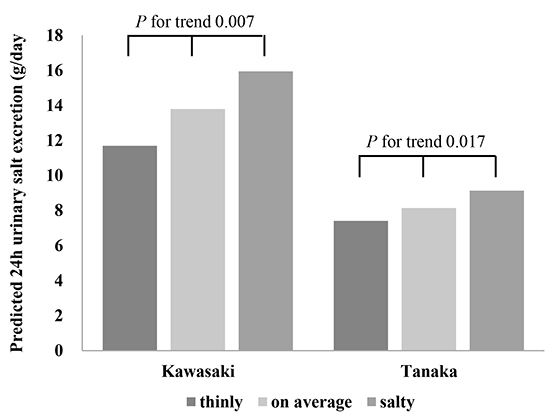1. Cook NR, Cutler JA, Obarzanek E, Buring JE, Rexrode KM, Kumanyika SK, Appel LJ, Whelton PK. Long term effects of dietary sodium reduction on cardiovascular disease outcomes: observational follow-up of the trials of hypertension prevention (TOHP). BMJ. 2007; 334:885–888.
2. Strazzullo P, D'Elia L, Kandala NB, Cappuccio FP. Salt intake, stroke, and cardiovascular disease: meta-analysis of prospective studies. BMJ. 2009; 339:b4567.
3. Bibbins-Domingo K, Chertow GM, Coxson PG, Moran A, Lightwood JM, Pletcher MJ, Goldman L. Projected effect of dietary salt reductions on future cardiovascular disease. N Engl J Med. 2010; 362:590–599.
4. Powles J, Fahimi S, Micha R, Khatibzadeh S, Shi P, Ezzati M, Engell RE, Lim SS, Danaei G, Mozaffarian D, et al. Global, regional and national sodium intakes in 1990 and 2010: a systematic analysis of 24 h urinary sodium excretion and dietary surveys worldwide. BMJ Open. 2013; 3(12):e003733.
5. Lee SW, Kim YC, Oh SW, Koo HS, Na KY, Chae DW, Kim S, Chin HJ. Trends in the prevalence of chronic kidney disease, other chronic diseases and health-related behaviors in an adult Korean population: data from the Korean National Health and Nutrition Examination Survey (KNHANES). Nephrol Dial Transplant. 2011; 26:3975–3980.
6. Beauchamp GK, Engelman K. High salt intake. Sensory and behavioral factors. Hypertension. 1991; 17:I176–I181.
7. Leshem M. Biobehavior of the human love of salt. Neurosci Biobehav Rev. 2009; 33:1–17.
8. Coldwell SE, Tordoff MG. Learned preferences for the flavor of salted food. Physiol Behav. 1993; 54:999–1004.
9. Hooper L, Bartlett C, Davey SG, Ebrahim S. Advice to reduce dietary salt for prevention of cardiovascular disease. Cochrane Database Syst Rev. 2004; CD003656.
10. Martikainen JA, Soini EJ, Laaksonen DE, Niskanen L. Health economic consequences of reducing salt intake and replacing saturated fat with polyunsaturated fat in the adult Finnish population: estimates based on the FINRISK and FINDIET studies. Eur J Clin Nutr. 2011; 65:1148–1155.
11. He FJ, MacGregor GA. How far should salt intake be reduced? Hypertension. 2003; 42:1093–1099.
12. Shim E, Ryu HJ, Hwang J, Kim SY, Chung EJ. Dietary sodium intake in young Korean adults and its relationship with eating frequency and taste preference. Nutr Res Pract. 2013; 7:192–198.
13. Drewnowski A, Henderson SA, Driscoll A, Rolls BJ. Salt taste perceptions and preferences are unrelated to sodium consumption in healthy older adults. J Am Diet Assoc. 1996; 96:471–474.
14. Chang Y, Park MS, Chung SY, Lee SY, Kwon HT, Lee JU. Lack of association between self-reported saltiness of eating and actual salt intake. Korean J Fam Med. 2012; 33:94–104.
15. Radimer KL, Harvey PW. Comparison of self-report of reduced fat and salt foods with sales and supply data. Eur J Clin Nutr. 1998; 52:380–382.
16. Kawasaki T, Itoh K, Uezono K, Sasaki H. A simple method for estimating 24 h urinary sodium and potassium excretion from second morning voiding urine specimen in adults. Clin Exp Pharmacol Physiol. 1993; 20:7–14.
17. Kamata K, Tochikubo O. Estimation of 24-h urinary sodium excretion using lean body mass and overnight urine collected by a pipe-sampling method. J Hypertens. 2002; 20:2191–2197.
18. Iseki K, Iseki C, Itoh K, Uezono K, Sanefuji M, Ikemiya Y, Fukiyama K, Kawasaki T. Urinary excretion of sodium and potassium in a screened cohort in Okinawa, Japan. Hypertens Res. 2002; 25:731–736.
19. Cogswell ME, Wang CY, Chen TC, Pfeiffer CM, Elliott P, Gillespie CD, Carriquiry AL, Sempos CT, Liu K, Perrine CG, et al. Validity of predictive equations for 24-h urinary sodium excretion in adults aged 18-39 y. Am J Clin Nutr. 2013; 98:1502–1513.
20. Beauchamp GK, Bertino M, Engelman K. Failure to compensate decreased dietary sodium with increased table salt usage. JAMA. 1987; 258:3275–3278.
21. Jeffery RW, Pirie PL, Elmer PJ, Bjornson-Benson WM, Mullenbach VA, Kurth CL, Johnson SL. Low-sodium, high-potassium diet: feasibility and acceptability in a normotensive population. Am J Public Health. 1984; 74:492–494.
22. Shepherd R, Farleigh CA, Land DG. The relationship between salt intake and preferences for different salt levels in soup. Appetite. 1984; 5:281–290.
23. Pangborn RM, Pecore SD. Taste perception of sodium chloride in relation to dietary intake of salt. Am J Clin Nutr. 1982; 35:510–520.
24. Mattes RD. Gustation as a determinant of ingestion: methodological issues. Am J Clin Nutr. 1985; 41:672–683.
25. David R, Peryam FJP. Hedonic scale method of measuring food preferences. Food Technol. 1957; 11:9–14.
26. Mattes RD. The taste for salt in humans. Am J Clin Nutr. 1997; 65:692s–697s.
27. Gregson RAM. A rating scale method for determining absolute taste threshold. J Food Sci. 1962; 27:376–380.
28. Wise PM, Breslin PAS. Individual Differences in Sour and Salt Sensitivity: Detection and Quality Recognition Thresholds for Citric Acid and Sodium Chloride. Chem Senses. 2013.
29. Son YJ, Lee Y, Song EK. Adherence to a sodium-restricted diet is associated with lower symptom burden and longer cardiac event-free survival in patients with heart failure. J Clin Nurs. 2011; 20:3029–3038.
30. Colin-Ramirez E, McAlister FA, Woo E, Wong N, Ezekowitz JA. Association between self-reported adherence to a low-sodium diet and dietary habits related to sodium intake in heart failure patients. J Cardiovasc Nurs. 2014; DOI:
10.1097/JCN.0000000000000124.










 PDF
PDF Citation
Citation Print
Print








 XML Download
XML Download